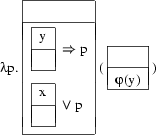11.6 Compositional Approaches to DRT
The method of DRS-threading clearly has a lot going for it. This construction method is declarative and suggestive in the way to think about meaning in terms of context change potential. But on the other side, the construction rules get complicated and the level of complexity will further increase if one attempts to add other linguistic phenomena.
An alternative way of constructing DRSs is to use the lambda calculus as we have been doing in Chapter 4 for building first-order logic representations for English expressions - in other words, formulating a purely compositional account. This is a tempting direction to take, but applying the lambda-based techniques to DRSs will inevitably lead to several practical and theoretical problems. (And that's why we refrained from using the lambda calculus in this chapter). Let's identify the most important of these problems - the interested reading is referred to the ``further reading'' section at the end of this chapter for pointers to the literature.
First of all, one needs a new operator to merges two DRSs and a process that transforms merged DRSs into an ordinary DRS (merge-reduction). An example illustrating the merge operator ; and merge-reduction is the following:

This sounds straightforward, but a number of technical problems are lurking behind the corner. What, for example, if discourse referents with the same name are declared in two DRSs that are part of a merge. A case in point is the following DRS:

Does this mean these discourse referents denote the same object? Or do we want to rename one of them and then allow merge-reduction? Or shall we disallow merging in such cases (thereby closing off the scope of one discourse referent)?
Another obstacle that arises when combining the lambda calculus with a formalism based on dynamic semantics is the way variables are treated. Discourse referents can be viewed as objects that can bind variables out of their syntactic scope. This will lead to technical problems when combined with lambda-bound variables - variables that have a static semantics. As a result, we need to extend the process of  -conversion to avoid accidental bindings. Moreover, without postulating further constraints in the formalism, bindings can appear to be ambiguous. Consider, for instance the following example:
-conversion to avoid accidental bindings. Moreover, without postulating further constraints in the formalism, bindings can appear to be ambiguous. Consider, for instance the following example:

During  -conversion the argument will be duplicated and the two resulting occurrences of y will have different status: in the consequent of the implication y will be bound, but in the disjunction, y will be free. This leads to a bizarre situation in the unreduced DRS expression above: is the occurrence of y in the argument free or bound?
-conversion the argument will be duplicated and the two resulting occurrences of y will have different status: in the consequent of the implication y will be bound, but in the disjunction, y will be free. This leads to a bizarre situation in the unreduced DRS expression above: is the occurrence of y in the argument free or bound?
Nevertheless, leaving some of these theoretical issues beside, using the lambda calculus can be of immediate practical importance when used as a pure ``glue-language''. In other words, we will use lambda-abstraction, functional application, and beta-conversion just as means to build discourse representations structures, and hence are not interested in semantically interpreting intermediate results. Probably the most convenient way of implementing the merge is to use a renaming operation on discourse referents to prevent clashes among variable names during the process of merge-reduction.